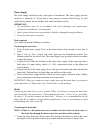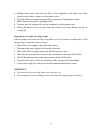
13
2. Find the drain outlet on the back of ice maker, then take off the rear drainage plug.
Connect the nut of the drain outlet to the water draining hose, and insert the other end
of the hose into the drain line.
3.
Screw off the water drainage nut and pull off the plug on the rear of the ice storage bin.
NOTE: Store the drainage nuts and plugs in the compartment labeled Nut/Plug Storage at
the back of the unit or in another safe place.
All horizontal runs of drain lines must have a fall of ¼” per foot. An air gap will likely
be required between the ice maker drain tube and the drain/waste receptacle. A stand
pipe with a trap below it would be acceptable for the drain/waste receptacle. A floor
drain is also acceptable. If this is not possible, FRANKLIN recommends the use of a
condensate pump. Contact Franklin Chef customer service at 1-888-424-8278.
4. Pour 1 gallon of water into the ice storage bin to check for leaks at all drain
connections and at the nut of the drain water hole. Tighten any connections or nuts that
leak.
If you don’t connect the drain hose
When you choose not to connect the drain hose, the water drainage nut on the rear of the
ice storage bin must be tightened .The drain outlet plug at the back of the ice maker should
be tightened also. Water collects in the ice storage bin through ice cube melting. The water
level in the ice storage bin can be seen at the water level indicator tube .When required,
the water must be discharged through the melt water drainage nut on the front of the ice
storage bin. The nut must be tightened afterwards. (Do not loosen or screw off the nut at
other times.) See Fig. A below.
IMPORTANT: Infrequent drainage will cause a high rate of melting in the ice storage bin.
IMPORTANT:
· Drain the melting water regularly or there may be a high rate of melting in the ice
storage bin if the water reaches the ice.
· The unit drains condensation water to the drainage tray on top of the compressor. The
water is slowly evaporated by the heat generated by the compressor. If the drainage
tray on top of the compressor becomes full of water, this is detected by the water full


















